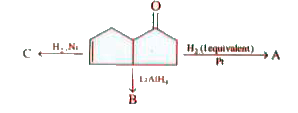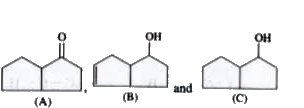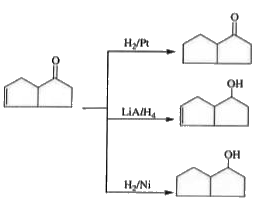What are A ,B and C in the given reaction ?
 Solution in Telugu
Solution in Telugu




The correct Answer is:D
Topper's Solved these Questions
- BOOK - AAKASH SERIESCHAPTER - ALDEHYDES AND KETONESEXERCISE - LEVEL-II LECTURE SHEET (EXERCISE-II)28videos
ALDEHYDES AND KETONES
- BOOK - AAKASH SERIESCHAPTER - ALDEHYDES AND KETONESEXERCISE - LEVEL-II LECTURE SHEET (EXERCISE-III)11videos
ALDEHYDES AND KETONES
- BOOK - AAKASH SERIESCHAPTER - ALDEHYDES AND KETONESEXERCISE - LEVEL-I(EXERCISE-II)59videos
ALDEHYDES AND KETONES
- BOOK - AAKASH SERIESCHAPTER - ALCOHOLS, PHENOLS AND ETHERSEXERCISE - ETHERS (OBJECTIVE EXERCISE-4)50videos
ALCOHOLS, PHENOLS AND ETHERS
- BOOK - AAKASH SERIESCHAPTER - ALKYL AND ARYL HALIDESEXERCISE - OBJECTIVE EXERCISE - 4 (ASSERTION (A) & REASON (R) TYPE QUESTIONS)19videos
ALKYL AND ARYL HALIDES
Similar Questions
Which of the following give N- subtituted amide from ketoxime ?
04:44View SolutionAldehydes and ketons are susceptible to nuclephlic addition because carbonylgroup

Polar (due to electronegativeity difference between carbon and oxygen
positive charge on carbonyl compound towards nucleophilic . this addition is catalysed by acid . REactivity of carbonyl compound towards nuclephilic addotion increase with increase in teh electron deficiency at carbonyl carbon Thus (-I.E ) groups increase while (+I.E ) groups decreases the reactivity of carbonyl compound .
which among the following is most reactive towards nuclephilic addition03:30View SolutionEthylene is converted to X on passing through a mixture of an acidified aqueous solution of palladium chloride and cupric chloride. Which of the following reagents readily take part in addition reaction with X ?
04:46View Solution(A): Alcoholic fermentation involves conversion of sugar into ethanol by the action of yeast.
(R): Fermentation involves the liberation of CO2 gas.01:25View Solution(A) Towards SN2 reaction, order of reactivity is CH3Br>CH3CH2Br>(CH3)2CHBr>(CH3)3CBr.
(R) Greater the stability of carbocation, greater will be its ease of formation from alkyl halide and faster will be the rate of SN1 reaction.View SolutionExplain the formation of (B), (C ) and (D) in the given reaction:
04:50View SolutionThe compounds A,B and C in the reaction sequence
_E01_524_Q01.png)
are given by the set :-04:02View SolutionWhat are (A),(B) and (C ) in the following reactions ?
04:00View SolutionIn the reaction sequences

A,B,C and D are given by the set:03:43View SolutionFor a given reaction 3A+B→C+D the rate of reaction can be represented by
03:36View SolutionIn the given reaction :

What are A, B and C respectively ?02:32View SolutionIn the given reaction, what is [B]?
 02:35View Solution
02:35View SolutionThe value of Kc for the reaction 2A→B+Cis2×10−2 At a given time the composition of the reaction mixture is [A]=[B]=[C]=3×10−3M What will be the direction of the reaction ?
05:56View SolutionIdentify A,B,C,"…." in the given reaction sequence .
02:08View SolutionIdentify A,B,C,"….." in the given reaction sequence .
03:33View SolutionFor a given reaction 3A + B to C + D the rate of reaction can be represented by:
01:30View Solution


